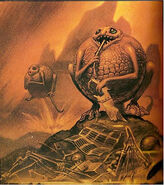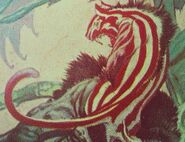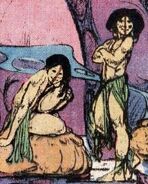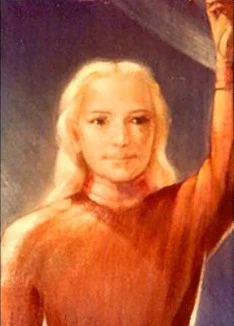
An artistic representation of Orthon, the man from Venus whom George Adamski has claimed to had contact with.
Venusians are beings who identify with the planet Venus. George Adamski called them "Space Brothers" in 1953.
George Adamski[]
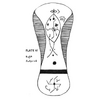
Seal of Orthon
George Adamski, who popularized the term "Space Brothers", had his first encounter with a Venusian in 1952, named Orthon. The Seal or Sigil of Orthon is inscribed on the bottom of Orthon's shoe. When he walked, Orthon's sigil left an imprint on the sandy ground. Adamski was in the Colorado Desert, near the town of Desert Center, California, at the time of his encounter with Orthon. Adamski made a quick copy of Orthon's shoe print, capturing the sigil of a gammadion.
Science fiction[]
The concept of inhabitants of Venus is a popular concept in science fiction, having been depicted in many different forms ranging from beautiful humanoids to strange sulfur-based lifeforms. The subject has also attracted interest from both ufology and astrobiology community's. In spite of the harsh environment that's claimed to be on the planet, the existence of life on Venus or at least microbial life and also finding evidence of advanced lifeforms from the past such as a crashed flying saucer or something more unknown is still considered possible nowadays.
Venus[]
Historically, Venus has always been viewed with interest by early astronomers. The fact that it is closer to the sun, has no moon near it and is entirely covered in dense clouds gave the idea of a hot, moist tropical world, which in turn gave an idea of a wasteland. Early science fiction stories had often depicted Venus as a swamp planet, a primitive world similar to what Earth might have been in the Carboniferous period. Another popular theory was that Venus could be a world completely covered by oceans, either made of water or of other substances.
The true nature of the planet was not revealed until the late 1950s, when astronomers were able to measure the temperature of Venus and found out that, thanks to a gigantic greenhouse effect caused by the high amount of carbon dioxide in the atmosphere, the temperature easily reaches more than 450ºC on the surface of the planet. This means that life as we know it is probably impossible, at least on the surface.
However, astrobiologists say that there is still a good chance of finding microorganisms living in Venus' clouds, where the temperature is much more appropriate. The existence of microbes living permanently in Earth's clouds seems to support this idea. By analyzing the atmosphere of Venus, scientists have found evidence that biological activity seems to be going on.[1] Also, we know now that Venus was once an Earth-like planet covered by oceans almost similar to Mars, so it is possible that life did exist there in the past.[2]
Popular culture[]
- In A Columbus of Space, by Garrett P. Serviss, Venus is inhabited by two distinct species. The inhabitants of the dayside are human-like, whereas those of the nightside are covered in fur and have huge light-sensitive eyes.
- A sapient species of fish-like Venerians inhabit the oceans of Venus in the novel Last and First Men, by Olaf Stapledon.
- Lucky Starr and the Oceans of Venus, a story by Isaac Asimov, depicts Venus as an ocean planet and describes many native species, both fauna and flora.
- In Isaac Asimov's short story "The Watery Place", two Venusians land their flying saucer in a small city in Idaho and try to make contact with the local sheriff, who is too busy working on his taxes to pay attention to them. The aliens appear exactly human, their true appearance being never revealed. Only after they go away does the sheriff see their spaceship and realize they were extraterrestrials, not Italians as he had thought ("Venus! When they talked about the watery place, I thought they meant Venice!").
- Also from Asimov; his early story "Half Breeds on Venus" depicts the planet as a tropical world inhabited by the sapient Phibs and by unintelligent dinosaur-like beasts known as Centosaurs.
- The Ymir is a large reptilian creature from Venus in the film 20 Million Miles to Earth.
- Venusians were depicted as small, non-sapient fossorial creatures in the Brazilian magazine Superinteressante.
- The book Venus, by Ben Bova, includes non-sapient, snake-like Venusians which use molten sulfur for blood, and microorganisms that live high in the atmosphere and break down ceramics and metals for their metabolism.
- In Doctor Who, Venusians have been mentioned at times in the series (the Doctor's third incarnation knows "Venusian Karate"). They do make an appearance in the First Doctor novel Venusian Lullaby by Paul Leonard, in which the Venusians are revealed as tentacled pentapods.
- There are indications that the Blobs, an amorphous species in Futurama, may actually be from Venus.
- Richard Sharpe Shaver's I Remember Lemuria mentions "young Halftan, of Venusian blood, long-legged, web-footed and fingered, his eyes huge and faceted", one of the classmates of Mutan Mion.
- In the comic strip Brewster Rockit: Space Guy! the character Ursula claims to be from Venus. Also, a Venusian Groundhog was featured in the strip in February 2 (Groundhogs Day), 2009.
- In ufology, Venusians are usually described as humanoid beings. George Adamski claimed to have contacted a Venusian man by the name of Orthon. Also, a woman called Dolores Barrios was once suspected by some to be a Venusian due to a perceived similarity with Orthon.
- Metal Slug has a race of Venusians.
- A Venusian species from the distant future is one of the many intelligences of the solar system mentioned in H. P. Lovecraft's The Shadow Out of Time. Lovecraft and Kenneth J. Sterling also wrote In the Walls of Eryx, featuring reptilianoid inhabitants of Venus.
- Edgar Rice Burroughs' Carson Napier series is set on Venus (a.k.a. Amtor) and features multiple native races including the Gan, Nobargan, Klangan, Zangan, Myposan, Vooyorgan, Brokols, Timals and the Cloud People.
- The cone-shaped monster from It Conquered the World is also a native of the planet Venus.
- A three-eyed Venusian famously show up in the The Twilight Zone episode "Will the Real Martian Please Stand Up?". Other variations of Venusians have been featured and mentioned in the series, such as stalk-eyed Venusians and tailed Venusians.
- Carnivorous women from "Sunev" ("Venus" spelled backwards) appear in The Three Stooges short film "Space Ship Sappy".
- The telepathic Venusian Worms from DC comics, of which Captain Marvel's enemy Mr. Mind is one.
- From cartoons based on the DC multiverse, we also have the Venusian Termites from Super Friends and two distinct Venusian species have appeared in the Superman/Aquaman Hour of Adventure.
- The Oucher-pouchers from Picture Atlas of Our Universe by Roy A. Gallant.
- In the film "Easy Rider", directed partly by Peter Fonda in 1969, the Venusians are discussed by Jack Nicholson's character, George. The two protagonists, Billy (played by Dennis Hopper) and Wyatt (aka Capt. America, played by Peter Fonda), are camping for the night with their hitchhiker, George. Billy and Wyatt partake in marijuana, and convince George, who is a small town lawyer, to try the drug. While he learns how to use it, Billy sees an object in the sky. George, now affected by the drug, calmly explains to Billy that what he saw was a UFO, and that the Venusians are an advanced species that the U.S. Govt hides from its citizens.
Gallery[]
(Edgar Rice Burroughs)
(Edgar Rice Burroughs)
(Edgar Rice Burroughs)
(Picture Atlas of Our Universe)
(Edgar Rice Burroughs)
(Edgar Rice Burroughs)
(Doctor Who)
(In the Walls of Eryx)
(It Conquered the World)
(The Man From Venus)
(Metal Slug)
(Oh, My Sweet Alien!)
(Superinteressante)
(Edgar Rice Burroughs)
(20 Million Miles to Earth)



